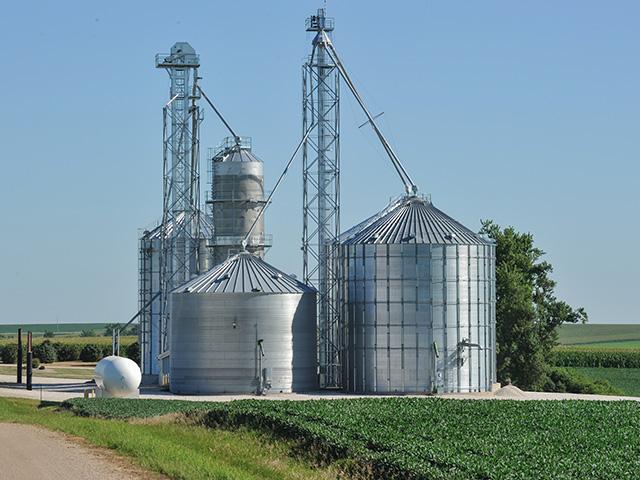Large Grain Bins Require Caution
Some Safety Practices to Follow Around Stored Grain
OMAHA (DTN) -- With on-farm grain bins becoming larger, the risk of injury or death from grain entrapment is real. However, grain entrapment is preventable. There are several steps producers can take to avoid issues with stored grain.
This was the topic of a recent webinar put on by University of Minnesota Extension and North Dakota State University Extension. The two Extension services are offering one-hour farm safety webinars on various subjects through March. (https://www.ag.ndsu.edu/…)
LOSS LEADS TO RESCUE TEAM
A grain entrapment death can devastate a community, but this horrible event can also lead to lasting change.
Rich Schock is the fire chief for the Kindred (volunteer) Fire Department located in Kindred, North Dakota. He is also a captain on the Sheyenne Valley Technical Rescue Team (SVTRT).
Schock's friend -- a fellow firefighter -- lost his life in a grain bin accident in 2008 on his family's farm. He entered an elevated bin and flowing grain killed him.
"It hit this department hard," Schock said.
Schock and others helped form SVTRT in response to the accident. The team responds to grain bin accidents and works to teach farmers about the dangers of grain bins.
Schock said if grain does not flow, there are certain safety practices farmers should follow.
SAFETY PRACTICES
The first thing is to lock out and tag out unloading equipment. Lock out tag out is a safety process in which a lock is put on a power source to keep the equipment from running, mainly to keep whoever is in the equipment fixing it from being injured or killed by the equipment. Tagging out involves adding a tag to the lock with the person's name on it so others can see who is doing it. This helps ensure those working around stored grain are safe as they investigate why the grain is not flowing, he said.
P[L1] D[0x0] M[300x250] OOP[F] ADUNIT[] T[]
People should know and understand that entering a confined space has its risks; farmers should never work alone with stored grain, and all safety equipment should be utilized.
Schock recommended farmers establish grain bins as zero entryways. If a grain bridge does occur, use equipment, such as long PVC pipes, to break up these spots in the bin without entering the bin.
FIRST THING TO DO
If someone does get trapped in a bin, the first thing to do is to call 911 immediately. Human nature is to go into the bin to help the trapped person, but this is how more victims of an accident happen, he said.
"I know this is hard, especially with family members, but emergency services should be called first, and don't go into the bin," he said.
PREVENTION IS KEY
North Dakota State University Extension Grain Drying Specialist Ken Hellevang said keeping grain in good condition is one step to prevent grain entrapment. Grain is best stored at low temperatures and lower moisture levels.
Grain must be dried down to lower levels if it is going to be stored for longer periods of time. While corn is harvested at 18% to 20% moisture, it will need to be dried down to the 13% to 14% range for long-term storage. (https://www.dtnpf.com/…)
Grain stored at 23% to 24% moisture does not want to flow very well and can lead to grain entrapment issues. Understanding the basics of grain storage management is important, he stressed.
"Crusting and bridging are usually issues with too wet and too warm grain," Hellevang said.
INCREASE IN GRAIN ENTRAPMENTS
Purdue University have been documenting and investigating incidents with grain storage and handling facilities since the 1970s. The 2019 report (https://drive.google.com/…) showed there were 67 fatal and non-fatal grain entrapments in the country in 2019, an increase of 9.8% over 2018.
There were 39 fatal grain entrapments in 2019. Minnesota, Iowa and Nebraska reported the most cases in 2019. Minnesota had 13 cases, while both Iowa and Nebraska had eight cases in 2019.
Hellevang said farmers building larger grain storage facilities with more flowing grain is a factor in the rising cases of grain entrapment deaths.
When he started at NDSU in 1980, most grain bins on farms could only store around 3,000 bushels. Today, grain bins can store 50,000 to 60,000 bushels.
Conveying equipment 40 years ago could only handle hundreds of bushels an hour, he said. Today, the same equipment can handle thousands of bushels an hour.
Hellevang said safety equipment is needed around stored grain, but farmers also need to examine the structure and design of their bins to make sure the bins can withstand the load of a safety harness, for instance.
Manufacturers have certain spots in mind for attaching safety equipment. Farmers need to be careful to find structurally sound locations on a bin for this type of safety equipment, he said.
To watch the entire ag safety webinar, go to: https://www.youtube.com/…
Russ Quinn can be reached at russ.quinn@dtn.com
Follow him on Twitter @RussQuinnDTN
(c) Copyright 2021 DTN, LLC. All rights reserved.




